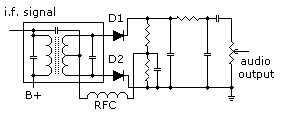
FM Receiver Basics - Part 2
|
|
|
|
FM Receiver Basics - Part 2 |
|
Now the principle differences between an f.m. radio versus an a.m. radio, and here for the moment we are talking about the entertainment variety, are:
(a) the need for VHF reception capability 88 - 108 MHz as against 0.54 - 1.65 Mhz for a.m. reception.
(b) the need for limiting action in the I.F. stages (see later discussion)
(c) a different means of detection of the audio i.e., recovering the frequency modulation.
(d) if we are talking f.m. stereo reception then some means of recovering left and right channel information.
In most entertainment variety receivers i.e. 88 - 108 Mhz the local oscillator operates at a constant 10.7 Mhz higher or lower than the received signal e.g. 98.7 Mhz to 118.7 Mhz. If you need to know why then go to previous tutorial on a.m. receiver design and learn just wh
LIMITING ACTION
Limiting can be described as the action of over amplification where the signal is overdriven in stages and subsequently "clipped". Looking at figure 5(a) below we can imagine what happens when it is amplified and clipped (5b), amplified once again and clipped again (5c).

Figure 5. - an a.m. modulated signal being clipped
Naturally we don't put a normal a.m. signal through a limiter, this is usually only done with f.m. signals. I simply provided figure 5 above so you could get the general idea. You should notice that all the amplitude modulation information (including noise) is progressively being removed. BTW 5(b) and (c) were simply done graphically by taking (a) resizing the height by 150% and cutting off the excess height (top and bottom) and repeating that exercise for (c). This is exactly what happens in a limiter only to a much greater amplification!.
To give you some idea of the amplification required for proper limiting go back to the old vacuum tube days where a good a.m. - i.f. amplifier might contain three vacuum tubes.
In the same period a good f.m. receiver may have had twelve or more tubes in the i.f./limiter stage.
A number of f.m. detection schemes have evolved over the years. The principal discrete ones were:
(a) F.M. Discriminator (figure 6)

Figure 6. - an f.m. discriminator
This discriminator simply works on the principal that with no modulation applied to the carrier there is no output at the detector. Briefly T1 converts the f.m. signal to a.m. and when rectified the output is still zero because they would be equal but opposite in polarity, if modulation is applied then there is a shift in the phase of the input component with a corresponding difference in the signals out of the diodes. The difference between these outputs is the audio.
As an aside, this is somewhat similar to some Automatic Fine Tuning (A.F.T.) schemes in some a.m. receivers, notably early T.V. receivers. With no frequency variation there is no output, with frequency drift there will be an output difference (in either direction) which is amplified and applied to front end tuning diodes for correction.
(b) Ratio Detector
The schematic looks a little similar to figure 6 but has a third (tertiary) winding on the secondary of T1, diode D2 has its polarity reversed and the two divider resistors are replaced by capacitors. This scheme was quite popular in entertainment type receivers. You detect f.m. but NOT a.m. and it placed some relaxation on the severe limiting requirements.
(c) Crystal Discriminator
Once favored by radio amateurs but superseded by later I.C. designs
(d) Phase Lock Loops
Among the relatively newer designs and PLL's overcome many of the drawbacks and costs associated with building and aligning LC discriminators.
Of necessity I have only given you a general overview and background so far and, for very good reasons.
Over the last 20 years developments in the manufacture of dedicated and complete f.m. receivers on a chip have made an in depth review of earlier information presented totally redundant.
These developments include companion devices to handle stereo reception.
Collin's Home Page Colin's Amateur Radio Page Colin's Snooker Page Colin's Guest Book Contact Me About Me
This Web page was last updated on Friday September 21, 2001
© 2001 Designed by Colin McCord